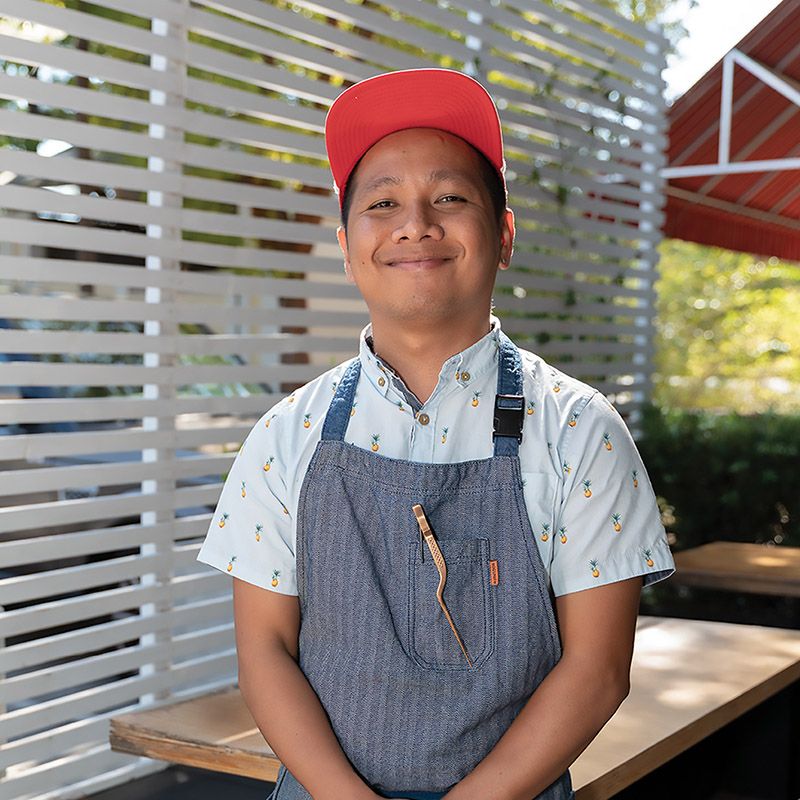Nikko Cagalan, on reviving his grandmother's recipes in the Lowcountry

Starting November 1, you can find Mansueta’s seven days a week at Workshop
CM: How did you get into cooking?
NC: As a kid in the Philippines, my grandmother made breakfast, lunch, and dinner daily. She went to the market in the morning and then again in the afternoon. Before school, the aromatic smell of her longaniza (sweet sausage) was our alarm clock. The first thing I made with her was a fried egg—hot wok, hot oil, crispy brown on the edge with a runny yolk. That’s something I will always remember.
CM: You grew up in Bacolod. What brought you to Charleston?
NC: My wife and I actually live in Conway (she’s a professor at Coastal Carolina University). We met in the Philippines and moved to the U.S. in 2011. I got my start in Boston restaurants before we came to South Carolina two years ago. I staged with chef Sean Brock during the 2018 Wine + Food festival, which led to a job under chef Vinson Petrillo at Zero George. I spent most of my income staying in a hostel between shifts, or on bus fare, commuting for almost a year. My wife would ask me what I was doing, and I just kept telling her it would pay off eventually. Now I’m cooking my food full-time.
CM: At your pop-up Mansueta’s?
NC: Exactly. It’s a Filipino pop-up using my grandmother’s recipes, with more refined plating—a skill I learned working in fine dining restaurants. Once I had the idea, there wasn’t a doubt in my mind that I’d name it after her; Mansueta’s is a tribute.
CM: How would you describe Filipino food to the uninitiated?
NC: To me, the Philippines is the melting pot of Asia. We were colonized by several different countries, and each one left behind an influence. We have pancit from China, adobo and menudo from Spain. And we’ve always used plenty of vinegar, because it makes food last longer, and a lot of people in the Philippines don’t have access to refrigeration. People love adobo (the national dish), but I’m also trying to feature less familiar foods such as Filipino-style picadillo (ground beef hash).
CM: Your adobo has a twist, right?
NC: I start by braising the meat, usually pork shoulder, with onion, garlic, ginger, scallion, vinegar, and soy sauce. Then I put my spin on the dish by adding coconut milk. After two hours, the meat is so tender that it falls off the bone.
CM: Are there any Thanksgiving-style meals in the Philippines?
NC: Filipino households are multi-generational; for special occasions, we have a communal feast called kamayan that started with the Philippine army. Traditionally, the soldiers would stand together at a long table and eat with no utensils. These days, kamayan dinners include family-style dishes on a banana leaf covered-table. There’s something so unique and enjoyable about eating with your hands, seated next to family.
CM: How does it feel cooking your food here in the South?
NC: I’m proud of the Filipino chefs cooking in big cities like L.A. and D.C. It’s great to help them shout that Filipino food is here to stay. When I get newcomers at my pop-up, they always leave knowing our food is delicious. I’m excited to collaborate in 2020 with Yana Gilbuena (a renowned traveling Filipino kamayan chef). Eventually, I’d like to open a restaurant so people can have a local spot to enjoy Filipino food all the time.
Photographs by (Cagalanan) David Walton Smith & (beer) Kate Fischer & courtesy of (thit rang) Little Miss Ha’s instagram